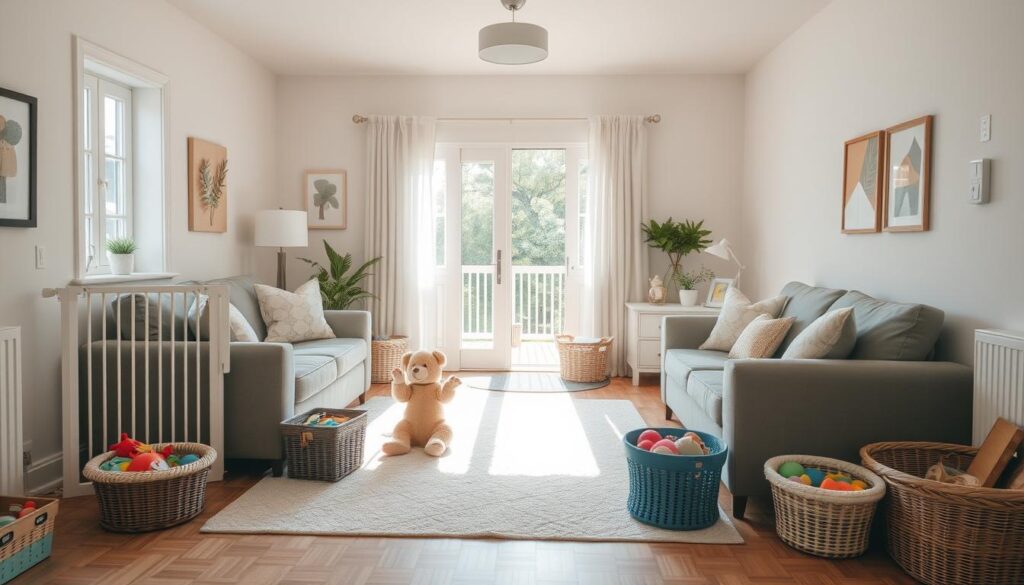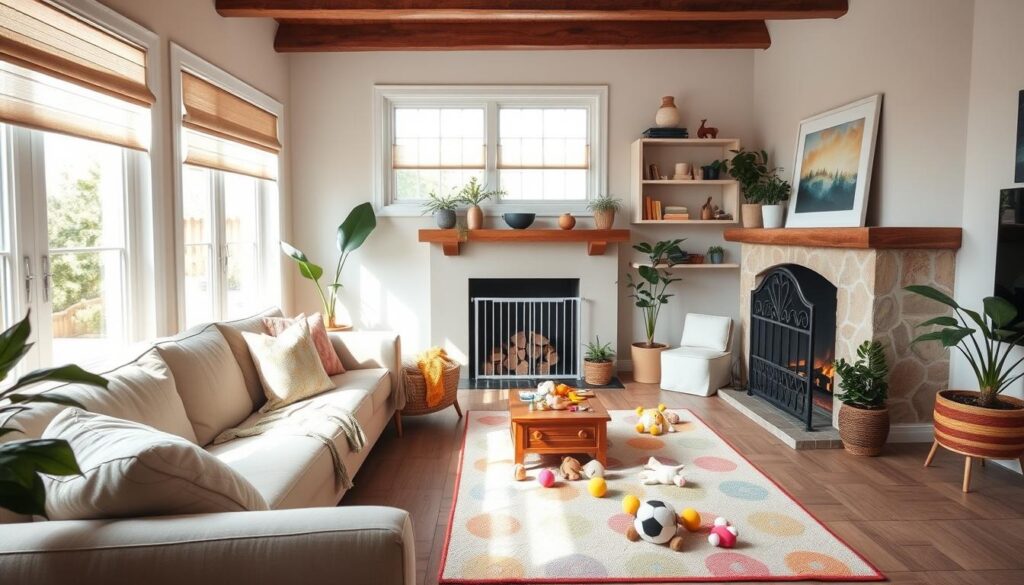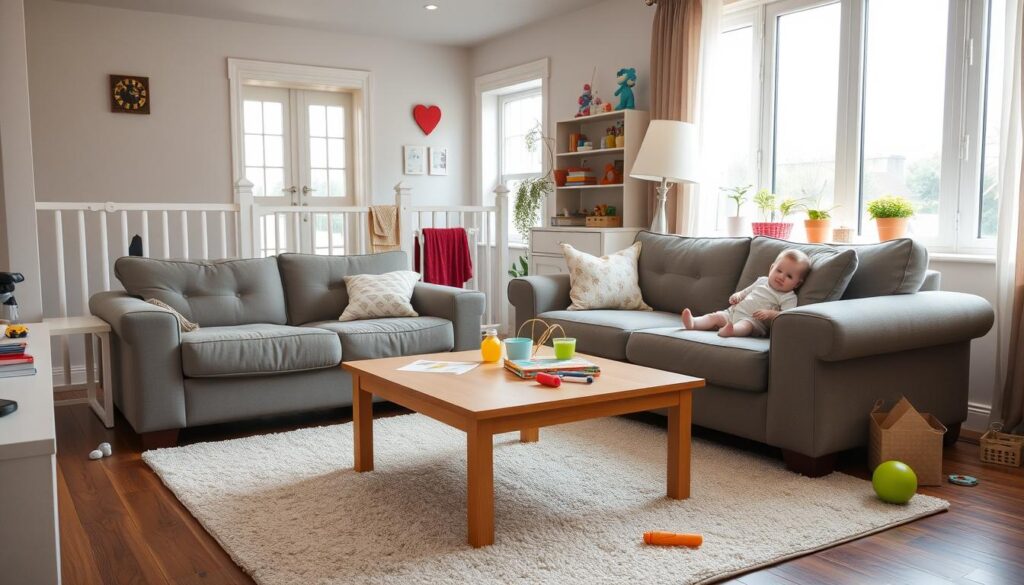As a parent, making your home safe for your little one is key. What steps can you take to keep your child safe and happy at home? Babyproofing is vital, and it’s more than just locking up furniture and cabinets. By following safety tips and using the right gear, you can make a safe space for your child to grow.
Introduction to Babyproofing
Creating a safe space for your little one needs careful planning and detail. You must check your home for dangers and fix them. This means putting up safety gates, securing big furniture, and keeping harmful stuff away. These actions help avoid accidents and keep your child safe.
Key Takeaways
- Creating a safe environment for your little one is a top priority for parents
- Babyproofing involves securing furniture and cabinets, as well as assessing your home for possible dangers
- Child safety tips and essential safety equipment are key to avoiding accidents
- Installing safety gates and securing heavy furniture can prevent injuries
- Keeping harmful materials out of reach is critical for your child’s safety
- By following these steps, you can create a safe and comfortable home for your child to grow and develop
Understanding the Importance of Babyproofing
As a parent, making your home safe for your child is key. Babyproofing helps prevent accidents and injuries. It’s vital to start before your child can move around, as they are most at risk then. A detailed babyproofing checklist helps spot dangers and take steps to avoid them.
Common dangers include sharp objects, electrical outlets, and heavy furniture. Sadly, accidents are a major cause of injury and death in kids under five. Knowing about childproofing essentials can greatly lower the risk of accidents and make your home safer for your child.
When to Start Babyproofing
It’s wise to start babyproofing early. Even before your child is born, it’s a good idea. This way, you can check your home and make any needed changes to keep your child safe.
Common Safety Hazards in the Home
Some common dangers in the home include:
- Sharp objects, such as knives and scissors
- Electrical outlets and cords
- Heavy furniture and appliances
- Hot surfaces, such as stovetops and ovens
Statistics on Childhood Accidents and Prevention
The American Academy of Pediatrics says accidents are a big cause of injury and death in kids under five. But, by babyproofing your home, you can greatly lower the risk of accidents. This makes your home a safer place for your child.
Essential Safety Equipment for Your Home
Keeping your kids safe at home is key. You need the right gear to protect them from dangers. Safety gates, outlet covers, and cabinet locks are must-haves. They block access to harmful areas and objects.
A baby monitor and a first aid kit are also vital. A baby monitor lets you watch your child from another room. A first aid kit prepares you for emergencies. These tools make your home safer for your child.

- Safety latches for doors and windows
- Corner protectors for furniture
- Non-slip mats for the bathroom and kitchen
These items prevent accidents and injuries. They give you peace of mind as a parent. By focusing on home safety for kids, you create a safe space for your children to grow.
| Safety Equipment | Purpose |
|---|---|
| Safety Gates | Restrict access to hazardous areas |
| Outlet Covers | Prevent electrical shock |
| Cabinet Locks | Restrict access to hazardous substances |
Remember, home safety for kids is a continuous effort. Always check your home for dangers to keep your child safe and happy.
Creating a Safe Environment for Your Little One: Room-by-Room Guide
As a parent, making your child’s environment safe is key. You need to check each room for dangers and add safety steps. This way, you make your home a safe space for your child.
In homes for kids, safety is very important. To keep your child safe, focus on safety steps for toddlers. Look at the kitchen, bathroom, living room, and nursery.

- Install safety latches on cabinets and drawers to block sharp objects and cleaners.
- Put non-slip mats and secure big furniture to avoid accidents.
- Keep electrical appliances away to prevent shock.
These steps help make your kitchen safe for your child. Remember, a safe home for kids needs careful planning and a focus on safety.
Securing Windows and Doors
As you babyproof your home, securing windows and doors is key. This step helps prevent accidents and keeps your child safe. Start by adding window guards, which are part of many baby safety products. These guards stop your child from falling out of windows, which is important on higher floors.
For doors, use door safety solutions like door stops and holders to avoid finger injuries. Make sure doors and windows are secure but can open easily in emergencies. Look into baby safety products like window locks and door alarms for more security.
Window Guard Installation Guide
Installing window guards is easy. You can find them at hardware stores or online. Choose a guard that meets safety standards and fits your window type.
Door Safety Solutions
Door safety solutions help prevent accidents and injuries. Use door stops to stop doors from closing too fast, and door holders to keep them open. These are great for places like the kitchen and bathroom, where doors can be dangerous.
Preventing Lock-ins and Lock-outs
To avoid lock-ins and lock-outs, ensure doors and windows are easy to access. Install door handles that are simple for kids to use. Also, think about smart locks that can be controlled from afar. They offer more security and convenience.
Electrical Safety and Cord Management
To keep your home safe, focus on electrical safety and cord management. This means covering all outlets and using cord protectors to avoid electrical shock. You can also use cord organizers or wall mounts to keep cords and wires out of reach.
Here are some important tips for electrical safety and cord management:
- Use tamper-resistant outlets to stop kids from putting objects in them.
- Don’t overload outlets with too many devices.
- Keep cords and wires away from heat sources like radiators or heaters.
By following these tips, you can make your home safer for your child. Always put safe household practices first when it comes to electrical safety and cord management.
Also, think about getting cord organizers or cord concealers. They help keep cords neat and secure. This makes your home look better and lowers the chance of electrical accidents.
| Electrical Safety Tips | Description |
|---|---|
| Cover electrical outlets | Use outlet covers to prevent children from inserting objects into the outlets |
| Use cord protectors | Use cord protectors to prevent electrical shock |
| Keep cords out of reach | Keep cords and wires out of reach by using cord organizers or securing them to the wall |
Furniture and Decor Safety Tips
Creating a safe space for your little one means looking at your home’s furniture and decor. As a parent, you want to keep your child away from dangers. Anchoring heavy furniture and appliances is a key step to prevent accidents.
Look around your home for heavy furniture or appliances that could tip over. Use anti-tip brackets or straps to secure them to the wall. This step helps prevent falls and keeps your child safe. Also, choose safe decorations like cordless curtains and blinds to avoid strangulation risks.
Anchoring Heavy Furniture
- Use anti-tip brackets or straps to secure heavy furniture to the wall
- Place heavy furniture away from doors and windows
- Ensure that all furniture is stable and secure
By following these tips, you can make your home safer for your little one. Remember, keeping your home safe is an ongoing task. With some planning and effort, you can prevent accidents and create a safe, happy home for your child.

Creating Soft Landing Zones
Creating soft landing zones is also important for safety. Place rugs and mats in areas where your child might fall. These zones can soften the impact of a fall and prevent injuries. Combining these tips with other safety measures can help protect your child from harm.
| Furniture and Decor Safety Tips | Benefits |
|---|---|
| Anchoring heavy furniture | Prevents tip-overs and reduces the risk of injury |
| Using safe decoration choices | Reduces the risk of entanglement or strangulation |
| Creating soft landing zones | Reduces the impact of a fall and prevents injuries |
Outdoor Space and Garden Safety
When making your home safe for your baby, remember the outdoors too. Your garden and yard can have dangers like pools, sharp things, and poisonous plants. Make sure to add these areas to your babyproofing checklist.
To keep your outdoor space safe, consider these childproofing essentials:
- Securely fence and gate any pools or water features
- Use soft surfacing materials in play areas
- Keep all plants and chemicals out of reach
By following these tips, you can make a safe place for your child to play outside. Always check and update your babyproofing checklist to keep your outdoor space safe for your little one.
With a bit of planning and care, you can make a safe outdoor space. This will let your child enjoy the outdoors and fresh air.
| Outdoor Safety Tip | Description |
|---|---|
| Pool Fencing | Install a fence around your pool to prevent accidental drowning |
| Soft Surfacing | Use soft materials like wood chips or rubber mulch in play areas |
| Plant Safety | Keep toxic plants out of reach and use non-toxic alternatives |
Maintaining Your Babyproofing System
To keep your home safe for kids, it’s key to regularly check and update your babyproofing system. This means looking for hazards and changing your setup as your child grows. Keeping your home safe for kids means staying current with new babyproofing products and tech.
Some important things to do include:
- Regularly check safety devices to make sure they work well
- Swap out broken or old items to avoid accidents
- Get smart home devices to watch over and lock down your home
By doing these things, you can make your home safer and more secure for your child. This gives you peace of mind and helps prevent accidents. Remember, keeping your babyproofing system up to date is an ongoing job. It needs your attention and effort to keep your home safe for kids.
Creating a safe and secure environment for your child is a top priority, and maintaining your babyproofing system is a key step to achieve this goal.
Age-Appropriate Safety Measures
As your child grows, their safety needs change. It’s key to use safety measures that fit their age. From newborn to preschooler, each stage has its own safety needs.
Newborn to Crawler Stage
It’s vital to make a safe sleep area for your baby. Use baby monitors and movement trackers. These tools help you watch over your baby and keep them safe.
Mobile Baby to Toddler
When your baby starts moving, make your home safe. Use safety gates and outlet covers. These steps help prevent accidents and injuries.
Preschooler Safety Needs
Teach your child about safety and basic rules. Like not touching hot surfaces or sharp objects. These safety measures help make a safer home for your child.
Some key baby safety products for each stage are:
- Baby monitors and movement trackers for newborns
- Safety gates and outlet covers for mobile babies and toddlers
- Secure furniture and decorations for preschoolers
By using the right safety measures and products, you can keep your child safe and sound.
Conclusion: Creating a Safe and Happy Home Environment
Creating a safe and happy home for your little one is a journey. It’s important to stay alert and check your home often for dangers. By following the safety tips in this article, you can make sure your child has a safe place to grow.
Teaching your child about safety is key. Involve them in making your home safe. This way, you all can create a space that’s good for growing, exploring, and having fun.
By being dedicated to safety, you can make a safe space for your child to flourish. Take on this challenge and enjoy the peace of mind that comes with knowing your child is safe at home.
